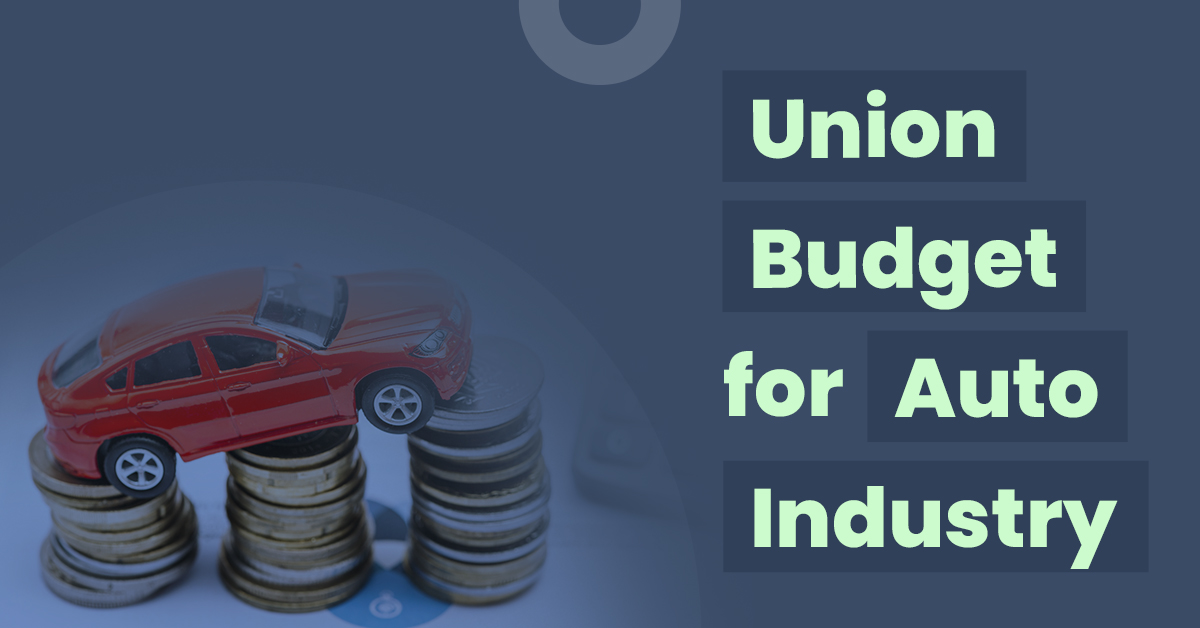Union Budget 2022 – Highlights on Union Budget for Auto Industry


The Union Budget of 2022, which was announced by the Union Finance Minister Nirmala Sitharaman, had a couple of essential provisions to boost the Indian auto industry in the budget. This budget has met certain expectations in relation to measures introduced for electric vehicles and automobile infrastructure development. Keep reading to know in detail about the provisions in the budget concerning the auto sector.
Overview of the Automobile Industry in India
Known as the ‘Sunrise Sector’ of India, the automobile sector is one of the rapidly growing sectors in India. At present, India exports automobiles to around 40 countries. The industry includes all automobile vehicles, such as two-wheelers, three-wheelers, quadricycles, passenger vehicles and commercial vehicles.
During the last financial year, the Indian automotive market was valued at $100 billion, which is expected to reach $160 billion by 2027. The compounded annual growth rate (CAGR) over the forecast period is 8.1%.
Currently, India ranks 4th in the world when it comes to automobile production. The country has an average annual production of motor vehicles that exceeds more than 4 million. The country is also the largest tractor producer in the world. Additionally, India ranks third in the world as a manufacturer of heavy trucks.
The automobile sector has a 7.1% share in the Gross Domestic Product (GDP) of India. In terms of export, automobiles hold a share of 4.7%. By 2025, the value of the Electric Vehicles (EV) market in India is estimated to reach ₹50,000 crore.
Automobile Sector in Union Budget – Key Announcements
The announcements made for the automobile industry will undoubtedly impact the sector in a positive way. However, there were no announcements made that could provide relief for this sector.
Some of the key announcements have been listed below:
Electric vehicles
- The primary focus of this budget is on the promotion of electric vehicles. Moreover, newer technologies will be incorporated for quicker adoption as well.
- There was an announcement about the new battery-swapping technology that will be introduced very soon. This technology will benefit the EV sector and enable the development of original equipment manufacturers. It will also help EV component manufacturers and charging infrastructure companies install battery-swapping stations around India. This will help create a massive number of job opportunities and lead to the fast adoption of electric vehicles.
- This year’s budget will significantly push the electric vehicle industry in India. The finance minister has announced the arrival of EVs in the public transport sector. This is a good move and will work towards encouraging and motivating automobile manufacturers to produce commercial electric vehicles for public transport.
- The introduction of electric vehicles as public transport will be beneficial towards curbing pollution. It will further reduce the consumption of fossil fuels and save them for future generations. Reduction in the dependency on fossil fuels will lower the costs of running vehicles. This, in turn, will provide better opportunities for the growth of the automobile sector.
Infrastructure
- The budget has focused on infrastructure projects by allocating ₹20,000 crore for transportation. It will help expand the network of National Highways to 25,000 km in 2022-23. Importance will be given to the improvement of road conditions to optimise the productivity and fuel efficiency of the vehicles.
- An increase in allocation for the infrastructure sector will ultimately lead to higher demands for commercial vehicles. This will benefit commercial vehicle manufacturers and help cover the losses they incurred during the pandemic.
- There was also an announcement about opening a defence research and development sector for private manufacturers. This might open a new growth segment for automobile component companies in India. Car manufacturers like Mahindra and Tata Motors are already working for the defence sector through their respective wings. They have been manufacturing vehicles for the Indian armed forces for a long time now.
Rural Automobile sector
This budget announced a Minimum Support Price payment of ₹2.73 lakh crore, along with other benefits, to help the farming sector. As a result, it will increase demand for automobiles in the rural market.
This will benefit the original equipment manufacturers as the rural markets contribute hugely to sales of two-wheelers, tractors, entry-level cars, SUVs and small commercial vehicles. In addition, it will help rural auto markets deal with the aftereffects of Covid-19.
Shortcomings of the Budget in Relation to the Auto Industry
Here are some of the shortcomings of the Union Budget of 2022 concerning the automobile sector:
- Not all announcements meet the expectations of the common people. There has been no announcement that will help overcome the rising input costs. Hence, there will be no drop in the prices of vehicles. Considering that customers will be paying more for the same vehicle is not what was expected.
- Demands such as tax cuts, revised duty structures, and incentives for new electric vehicle adoption have also not been met.
- The government has again side-lined the long-standing demand of the automobile industry for reducing GST rates. All auto and related products are currently taxed at the level of luxury items. They fall in the highest bracket of 28%. Apart from that, a cess of 1% to 22% is also levied if vehicles exceed a specific engine size and body. This might make vehicles unaffordable for buyers.
- Individual taxpayers and salaried middle-class individuals have expressed their disappointment as the finance minister did not announce anything to provide relief to the segment.
Implications of Union Budget Allocation on the Automobile Sector
Here are the ways the Union Budget might affect the auto sector in India:
- An increase in Capex expenditure and focus on infrastructure will have a significant impact. The government has announced a rise of 35.4% in Capex to ₹ 7.5 lakh crore for the upcoming year against ₹5.54 lakh crore in the current year. This will provide the much-required impetus for the commercial vehicle sector and the Medium and Heavy Commercial Vehicles segment, which suffered a lot during the pandemic.
- The Raising and Accelerating MSME Performance (RAMP) program, which has an outlay of ₹6,000 crores, will offer a much-needed boost to the manufacturing space. The objective of this program is to improve credit and market access of MSMEs.
- The announcement of MSME payment will enhance rural income and improve rural consumption by putting more money in the hands of the farmers. It will further uplift rural sentiments and create a positive ecosystem for the two-wheeler and tractor segment.
- Including private players in defence research and development will allow auto component companies to generate more revenue. However, there will be a positive impact only on certain large-scale suppliers who have the capacity to meet the tough requirements of the armed forces. Therefore, this announcement will not considerably impact medium and small-scale auto component suppliers.
- An increase in import duty for certain components will encourage local manufacturers. However, this can increase the price of vehicles initially, along with a rise in input costs that might hurt the overall demand.
Final Words
Whether it is the higher investment made in the infrastructure sector or an increase in the import duty for specific car components under the ‘Vocal for Local’ campaign, the measures announced in the budget will surely impact the automobile sector positively.
Better road conditions will decrease vehicle maintenance costs, and mass introduction of electric vehicles will reduce pollution levels. In addition, helping the farming sector financially will increase the development of semi-urban and rural auto markets.
Frequently Asked Questions
What is the production-linked incentive scheme for the automobile sector?
The production-linked incentive scheme for the automobile sector has an outlay of 3.5 billion US dollars. It proposes a financial incentive of up to 18% to boost domestic manufacturing of advanced automotive technology products. This will further attract investment in the automobile manufacturing value chain.
What is the automotive mission plan for 2016-26?
This plan outlines the trajectory of growth of the automotive ecosystem in India. The plan provides a definite path that offers regulations and policies that will govern research, technology, design, testing, sale, import/export, repair, use and recycling of vehicles, services and components of the auto sector.
What are the challenges faced by the automobile sector in India?
One of the major challenges faced by the automobile sector is the demand for ride-share apps. This has resulted in a decreasing demand for commercial vehicles, especially in metropolitan cities. Apart from this, there is tight credit availability as the banks have become cautious about supplying credit for car purchases.



